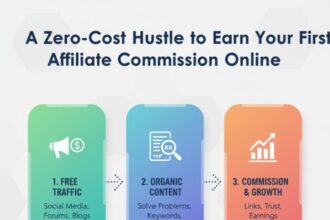My Tech Stack Was a Dumpster Fire. Here’s How I Put It Out.
My laptop felt hot on my lap. The bad kind of hot. The kind that tells you the fan is screaming and you’ve been staring at the screen for way, way too long.
It was probably 1 AM.
The only thing on the screen was a blinking line. The cursor. Just pulsing. Mocking me.
This was supposed to be it. The beginning of my new life. My escape plan from a job that was slowly draining the color from the world. I was going to build a business online. Be my own boss. All that stuff.
But I was stuck. Completely paralyzed.
I had twelve tabs open. At least. One was for a social media scheduler. Another was a “funnel builder” (I still don’t really know what a funnel is). Another was for a project management tool that looked like it was designed to launch a NASA mission.
I felt a hot, prickly feeling creep up my neck. The kind of feeling you get when you know you’re in way over your head.
I was trying to figure out the essential tech frameworks for female entrepreneurs, but honestly, I just felt like a fraud. A girl playing dress-up in a CEO’s office.
I almost slammed the laptop shut that night. For good. I thought, maybe I’m just not cut out for this. Maybe I’m not “techy” enough.
This isn’t a guide from a tech genius. I am the least techy person you will ever meet. This is the story of how I dug myself out of that hole. It’s the story of how I went from being terrified of technology to just… using it.
And it started with me admitting that my brilliant plan was actually just a dumpster fire.
My First Stupid Mistakes with All This Tech Stuff
My initial strategy for building my business tech? Chaos. Pure, unadulterated chaos.
I was like a kid in a candy store with a stolen credit card. I signed up for every free trial I could find.
I had this idea that the more software I used, the more “real” my business would feel. It was a classic case of faking it ’til you make it, except I wasn’t making anything. I was just accumulating passwords.
It was a nightmare. Nothing worked together. I’d have to log into five different things just to figure out what I was supposed to be doing that day. I was spending more time managing my tools than I was actually building my business.
What Even IS a “Tech Stack”? And Why Did It Make Me Feel So Dumb?
I kept hearing this phrase. “Tech Stack.”
It sounded so… serious. Like something people in Silicon Valley boardrooms talked about.
I got obsessed with it. I started choosing the right tech stack before I even had a product to sell or a single customer. I watched hours of YouTube videos where super-successful entrepreneurs would show off their systems. They had these complicated diagrams with arrows and acronyms. It was intimidating as hell.
I thought that was the price of admission. I thought I had to have that level of complexity to be successful.
So I tried to copy them.
I signed up for the most powerful email marketing tool, even though I had zero subscribers. I signed up for a team-based project manager, even though my “team” was just me and my very confused cat.
My “tech stack” was a joke. It was a wobbly, mismatched tower of software that made me feel more incompetent every time I looked at it.
The Time I Lit $300 on Fire for a “Magic” Solution
This was the low point. The absolute bottom.
I was so tired of trying to tape everything together. Then, I saw an ad. An ad for an “all-in-one” platform that promised to be the answer to all my prayers. Website. Emails. Courses. Sales. It did everything.
It was expensive. Really expensive for me at the time. But I was desperate. I thought, “This is the shortcut. This is what the pros use.”
So I paid for it.
And the next three weeks were some of the most frustrating weeks of my life.
The platform was a monster. Because it tried to do everything, it did nothing well. It was slow. It was confusing. The tutorials were made by engineers who clearly had never met a normal human being.
I distinctly remember a Tuesday afternoon where I spent two full hours trying to figure out how to change the color of a button on my website. A button color.
I just sat there and cried. Real, actual tears of frustration. Over a button.
I had paid a premium price to feel like a complete and total idiot. And that, it turns out, was the wake-up call I needed. I wasn’t the problem. My entire approach was.
The Lies About Tech That Almost Made Me Quit
After the button-color-meltdown, I was done. I cancelled my subscription to the “magic” platform and just sat in silence for a while.
I started to get angry. Angry at all the “gurus” and all the “experts” who made this stuff sound so easy.
The more I thought about it, the more I realized that the world of online business is built on a few really persuasive, really damaging myths about technology.
The Big Lie: “You Need the Best Tools to Succeed.”
This is the most common trap. We see what the big names in our industry are using—the fancy, expensive software—and we think that’s what we need to get started.
It’s a complete fantasy.
They didn’t start with that stuff. They started with something simple and grew into it. Giving a beginner the most powerful, complex tool is like giving a 16-year-old with a learner’s permit the keys to a Formula 1 car. They’re just going to crash. And it’s not their fault.
You don’t need the best. You need the simplest tool that gets the job done. Period. Anything else is just procrastination in disguise. The goal isn’t to have an impressive software toolkit; it’s to get your idea off the ground. That’s it. That’s the only thing that matters at the beginning.
The Sneaky Lie: “I’m Just Not a Tech Person.”
How many times have you heard someone say that? How many times have you said it yourself?
I said it constantly. It was my go-to excuse. My get-out-of-jail-free card for not trying.
But it’s a lie. A story we tell ourselves.
You don’t need to know how to code. You don’t need to understand what an API is. You just need to be persistent. Being “good with tech” is really just a synonym for “being willing to patiently Google error messages.” That’s the whole secret.
I read a piece in the Harvard Business Review once about how leaders introduce new tech into a company. It blew my mind. It wasn’t about their technical skill; it was about their clarity of vision. They knew what they wanted the tech to accomplish. You can find that article here. That’s when I realized I didn’t need to be a techie. I just needed to know what I was trying to build.
The Seductive Lie: “Automate Everything!”
Oh, this one is so tempting. The dream of a business that runs itself. You just set up some automations, and then the money rolls in while you sip margaritas on a beach.
I fell for this one hard. I tried automating small business tasks before I even knew what my tasks were.
It was a disaster.
You can’t automate a process you haven’t done yourself. Manually. Painfully. Over and over again.
That manual work isn’t a chore; it’s research. It’s how you learn the sticking points. It’s how you discover what your customers actually need. You have to walk the path and clear the branches yourself before you can hire a machine to pave it.
The Simple, Obvious Idea That Changed My Entire Business
I was at rock bottom. My fancy software was cancelled. My confidence was shot. I was back at square one.
I took out a piece of printer paper and a Sharpie. And I just sat there.
I stopped thinking about tools. I stopped thinking about funnels and stacks and automation.
I asked myself one question. A question so simple, I was almost embarrassed I hadn’t asked it before.
“If I was my own customer, what would I want to happen?”
And that was it. That was the “aha!” moment.
The tech isn’t the business. The tech is just the plumbing. It’s the boring, invisible stuff inside the walls that makes the house work.
No one ever bought a house because it had amazing pipes. They bought it because they loved the kitchen, or the big backyard, or the way the light came in through the windows in the morning.
I had been obsessing over the pipes.
How I Was Getting It All Wrong
For months, I had been letting the tools lead the way. I’d find a cool piece of software, and then I’d try to invent a reason to use it in my business.
It was completely backward. It was like going to a hardware store, buying a random saw, and then wandering around your house looking for something to cut.
It makes no sense.
You have to start with the project. You have to know what you’re trying to build. Only then do you go to the hardware store to find the right tool for that specific job.
My business wasn’t my email provider or my project manager. My business was my idea. My voice. My ability to help someone solve a problem. The tech was just supposed to help me do that.
My Hand-Drawn Stick Figure That Became My Business Plan
So, on that piece of paper, I drew a stick figure. I named her Sarah.
Sarah was my ideal customer.
And I just started drawing her journey. A messy, ugly flowchart with boxes and arrows.
Sarah feels stuck. She finds one of my blog posts on Google. (Okay, so I need a blog. A simple one.)
She likes the post. At the bottom, there’s a box where she can get a free checklist. (Okay, so I need a way to deliver a PDF and collect an email address.)
She gets the checklist. She’s on my email list. (Okay, I need an email marketing tool. A simple one.)
A week later, I email her about a small digital product I’m selling. (Okay, I need a way to take a payment. A simple one.)
That ugly drawing was the most powerful business document I’ve ever created. It became my North Star. It simplified everything.
Every tech decision was no longer about which tool was “best.” It was about which tool was the simplest, easiest way to help Sarah take the next step on her journey. It’s a concept I touch on in my post, My Love-Hate Relationship with Finding My Niche, because it all starts with knowing who “Sarah” is.
My No-BS, “It Works for Me” Tech Toolkit
So, what do I actually use now? After all that drama?
It’s so simple it’s almost boring. But it works. And it lets me spend my time on my actual business, not on being a frustrated IT help desk for myself. This is my cobbled-together system. Steal it if you want.
1. The Home Base (My Website): I use WordPress.org. Not the free WordPress.com, the self-hosted one. It costs me about a hundred bucks a year for hosting. It’s like buying a plot of land on the internet that I actually own. I bought a simple theme for $60, and I try to use as few plugins as possible. Simple.
2. The Friendship-Maker (My Email List): This is the most important thing. It’s my direct line to my people. I use MailerLite. It’s free for your first 1,000 subscribers, and it’s dead simple to use. I wrote about the pain of getting started with this in my post, How I Finally Started Building an Email List (Without Losing My Mind).
3. The Brain-Dump (My Project Manager): I live and die by Trello. It’s free. It’s just digital sticky notes on a board. I have a board for my content ideas, my weekly to-do list, and my crazy “someday” projects. It stops my brain from feeling like a browser with 50 tabs open. This is the heart of simple project management for solopreneurs.
4. The Blueprint (My Customer Map): I still use paper for this sometimes. But when I want to get fancy, I use a free tool called Miro. It’s just a giant online whiteboard where I can draw my messy flowcharts. Building a customer journey map sounds corporate and awful, but it’s really just doodling. This five-minute doodle saves me from making thousand-dollar mistakes.
5. The Cash Register (Getting Paid): When I want to sell a simple digital product like an ebook, I use Gumroad. It’s free to list products, and they just take a small cut of each sale. For any client or service work, I use Stripe. Easy.
6. The Robot Butler (My One Automation): I only did this after I was in business for a solid year. I use Zapier (the free version) for one thing. When someone buys my product on Gumroad, Zapier tells MailerLite to add them to my email list. That’s it. It’s one tiny task I don’t have to do manually anymore. The Zapier blog is great for learning the basics if you get curious.
And I’m serious, that’s it. That’s the whole “stack.” I also follow the basic security advice from the Federal Trade Commission, which you can find here, because a simple system is way easier to keep safe.
So, Am I a Tech Guru Now? (Spoiler: Not Even Close.)
The woman who cried over a button color? She’s still in here. I still get that knot in my stomach when I have to learn a new piece of software.
I will never be a “tech person.”
But I’m not scared anymore.
The technology isn’t the boss of me. It’s a tool. A simple, sometimes annoying, but ultimately useful tool. Like a hammer. I don’t need to be a master carpenter to hang a picture on the wall.
This whole messy journey wasn’t about learning technology. It was about learning to trust myself. It was about realizing that I didn’t need to be anyone else. I didn’t need to have a fancy, complicated system to have a real, valuable business.
I just needed to focus on helping people.
If you’re where I was, staring at that blinking cursor and feeling like a fraud, please hear me. You have everything you need to start. You are capable enough. You are smart enough.
You just need to get out of your own way.
So, let me ask you this. What’s the one tool, the one piece of tech, that’s making you feel stupid right now? Just name it in the comments. Let’s call it out and take away its power.





































i am interested in this.
http://www.postyin.com